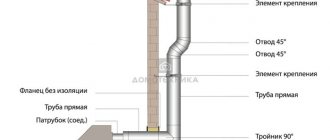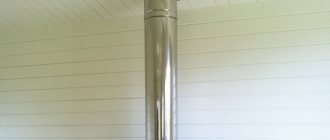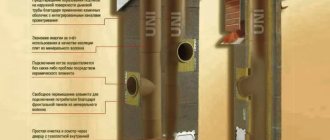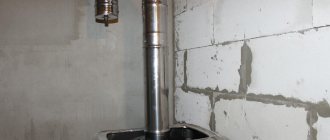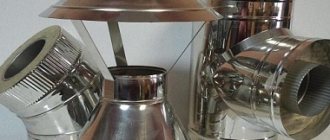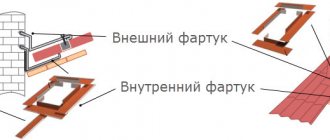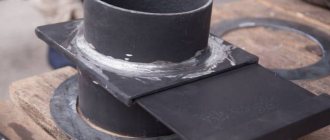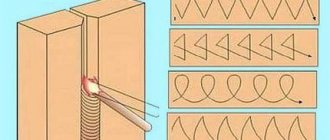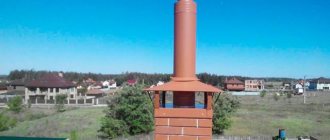Home / Boiler automation
Back
Published: 08/13/2019
Reading time: 3 min
1
15349
A boiler economizer is a device that has a long operating history. It takes its name from the English word “economize” - “save”, and was developed in 1893 with the creation of the first water-tube steam boiler, Shukhov, in Russia.
Today, such units are used everywhere when water is heated in a regenerative cycle, ranging from individual heating to large energy generation systems. Without the use of this simple device, it is impossible to achieve an efficiency of boiler units of 90-95%.
- 1 Why do you need an economizer?
- 2 Operating principle
- 3 How to make it yourself
- 4 Installing an economizer in the system
When is a convector chimney used?
The feasibility of using a convector chimney is determined by the overall design of the heating system. It’s good when a stove, boiler, or fireplace serves as a constantly functioning heating device. A convection chimney is most effective when burning solid fuel.
A chimney economizer significantly increases the efficiency of the entire system, effectively heats adjacent rooms, and prevents harsh infrared radiation from the chimney.
Water economizers are widely used on an industrial scale, using the thermal energy of flue gases to preheat water circulating through heating pipes. At home, it is extremely difficult to achieve effectiveness from such a system.
Convector chimneys are often used in sauna stoves. Some models have a mechanism for closing convection channels to control heating. To quickly heat the steam room, the external air suction passages are blocked, all the thermal energy from the stove and chimney is used to warm it up. When the required temperature is reached, the valve opens again and air circulates through the heat exchanger to adjacent rooms.
Tips for use
You can purchase an economizer for a boiler room in assembled form or order its production according to a drawing. This way you can achieve the greatest efficiency. If the unit is planned to be used in industry, then the possibility of manufacturing it according to an individual project allows you to reduce production costs.
When planning to install an economizer in a boiler room, you must study the purpose and specific operation of the device and select additional equipment of the appropriate type, taking into account the design features of the heating system. Otherwise, inconsistency of equipment elements may make it impossible for them to function completely. For example, economizers for a boiler room of the popular DKVR 10-13 model should be connected according to a special scheme, then they will be able to provide optimal efficiency. The calculation should be made by specialists taking into account the basic initial data in each specific case.
You can contact JSC MPNU Energotekhmontazh. The company provides comprehensive services for the construction of boiler houses: creates projects, makes calculations and selects equipment, puts into operation objects of any complexity. Contact details are listed on the website. Call us, we will be happy to help.
Design and principle of operation of a chimney with an economizer
The chimney-convector is manufactured from heat-resistant, high-alloy steel, chromium content - 13%. The economizer must have anti-corrosion, acid-resistant properties. Some models have an upper casing made of natural or bush hammered stone - marble, soapstone, jadeite, which accumulates heat well and distributes it evenly.
A convector chimney is a module of two components with different wall thicknesses:
- The internal chimney pipe (steel thickness 1 mm) is the passage of hot gases.
- External pipe system of the heat exchanger casing (steel thickness 0.5 mm).
Factory economizer for chimney
The economizer is mounted at the beginning of the chimney and is its intermediate, but internal link - it leaves the chimney and then enters again. Its length varies from half a meter to a meter.
The longer length contributes to better heating of the air due to the increased area of contact with the chimney pipe.
The short version of the economizer is suitable for rooms with low ceilings. The penetration of carbon monoxide into the external pipes is excluded; only air circulates through the convection tubes.
The design of convector chimneys can be simplified, with a number of holes for air intake along the edges. Designed to quickly warm up and remove excess heat from the surface of the chimney. The modification for bath rooms is equipped with an external basket where stones are placed that accumulate heat.
Installation standards and rules
Installation and operation are carried out with mandatory compliance with the requirements specified in the current regulatory documents:
- SNiP 41-01-2003, which describes the operating standards of heating, ventilation and air conditioning systems.
- SNiP 23-01-99, regulating issues of construction climatology.
- SNiP 42-01-2002, which prescribes the principles of operation of gas distribution systems.
- Code of fire safety rules in the Russian Federation.
- Other documentation on the operation and installation of convector-type chimneys.
Features of a chimney economizer
Devices with two pipes can heat one room, while devices with four can heat two adjacent ones. Pipes made of 0.5 mm steel with a diameter corresponding to the hole diameter of 11.5–12 cm are attached to the nozzles. The structures must be brought into the intended room through the wall - through a passage made.
The passage structure depends on the material of the walls. In the case of the presence of flammable material, the exhaust pipe must be covered with thermal insulation - basalt fiber.
Operating principle of the economizer
The length of the chimney is selected based on the distance from the economizer to the wall, but the smaller it is, the warmer the air being exhausted. The converter device comes with half-meter pipes; if necessary, they need to be extended.
Sometimes stainless steel corrugation is used if it is difficult to install the pipe on a straight part of the wall. Decorative nozzles are installed on the outer ends of the pipes. The pipes through which cold air is sucked in are located below, preferably no higher than 0.2 meters from the floor.
The warm air coming out of the upper pipe gradually cools, falls and is sucked into the lower part. To enhance air circulation, it is necessary to install a fan from the lower entrance in the heated additional room. The sucked in cold air enters the convector, heats up from the smoke exhaust duct and appears through the upper pipe into the room.
From below, at the chimney outlet from the furnace firebox, the economizer is secured using heat-resistant sealant; the continuation of the main chimney is connected from above in the same way.
What is an economizer for a boiler?
A boiler economizer (thermal exhaust heat recovery unit) is a heat exchange unit that increases the efficiency of the device due to already waste energy.
This is what a standard simple economizer looks like.
In fact, it takes on the heat of exhaust combustion products (flue gases), which is released during the operation of almost any boiler (including solid fuel and gas), accumulates it and sends it to the original coolant for additional beneficial use.
This is what a simple economizer for a domestic boiler looks like
What is it and what is it for?
In fact, the economizer is an optional part for the boiler, which adds the ability to preheat the coolant without using the main (released during fuel combustion) thermal energy of the equipment, which helps to optimize its operation as much as possible:
- avoid air pollution - preventing the release of superheated (carbon) gases helps maintain environmental and hygienic cleanliness;
- extend the service life of the equipment - fast heating and maintaining heat allows you to avoid sudden temperature changes that are detrimental to the boiler;
- reduce heating costs - reducing energy consumption (by 4–18%) ultimately leads to significant savings in money.
Thus, in conjunction with autonomous high-power boilers, the cost of the economizer pays off within 2–3 years of constant use.
Design and operating principle
In the basic version, the economizer device is a multi-stage system of serpentine or zigzag tubes. These tubes are combined in several sections (of a general configuration) into one block, which is lined with a heat-insulating frame for safety reasons.
At the bottom of the structure there is an inlet pipe for supplying water, and at the top there is an outlet pipe for collecting coolant. Also, a safety valve is mounted directly in front of the inlet line: its main purpose is to protect the pipe connections from sudden pressure surges (water hammer).
The exhaust gases transfer heat to an economizer built into the exhaust system.
The principle of operation of the economizer is to create a counter-current movement pattern of the heated element and exhaust flue gases: water is forced (by a pump) and sequentially goes upward, and combustion products, on the contrary, are directed downward, which ensures better heat exchange.
Convector chimney at home
The design of convector chimneys is quite simple, it is easy to make it yourself. The economizer is a pipe corresponding to the diameter of the chimney, on the outer surface of which special pockets are welded for air circulation. These can be small diameter pipes, rectangular profiles or metal plates.
Economizers are installed in the presence of a metal chimney; they cannot be installed on a ceramic chimney pipe.
Food-grade stainless steel is best suited for the manufacture of convector structures. It withstands high temperatures well and is resistant to aggressive environments. This device has a long service life.
Another material is galvanized steel, but it is capable of releasing toxic substances when heated strongly - 200 degrees and above. Household ovens operate at lower temperatures, so the material is considered suitable for economizer applications.
Types of devices
Economizers for boiler rooms are available in several types. The main differences lie in the degree of heating of the coolant, materials, operating features, and layout. According to the listed characteristics, such devices are:
- Boiling or non-boiling type.
- Steam and for heating water.
- Cast iron and steel.
- Surface, contact type.
- Smooth pipe and with ribbed communications.
Each type of economizer is available in a variety of models, the difference between which lies in the technologies and equipment used in their creation.
Metal economizer and its features
Economizer operation diagram
To make an iron chimney you need a welding machine. Work schedule:
- Prepare a pipe with the diameter of the existing chimney and cut it to a length of about 0.5 meters.
- Cut another small diameter pipe of 50–70 mm so that you get 6–8 pieces 7–10 cm long less than the main inner pipe.
- Weld small-diameter pipes to the main surface to arrange them around, but only at the same distance from each other.
- Connect the economizer to the chimney from above and below.
- The finished economizer can be surrounded with a protective casing on top to give it an aesthetic appearance and painted black for better heat transfer.
Stainless steel economizer:
- Prepare a stainless steel chimney pipe and a sheet of the same material, but of smaller thickness.
- Attach several sheet pockets to the pipe with rivets, bending them in the form of waves.
- Connect the device to the stove flue.
- The outside of the economizer is treated with stove varnish.
A convector chimney made of stainless steel is easier to make than a metal one; its installation does not require welding.
The air trapped in the pockets of the convector heats up and appears hot on the opposite side.
General rules for installing an economizer:
- The location of the device must be at the bottom of the chimney.
- It is necessary to exclude the presence of flammable objects nearby.
- For water economizers, installation is advisable if the water can heat up to 250 degrees. Otherwise, the boiler power will not be enough.
Drawings and calculations
In order for the device to fit into the overall scheme of the heating system, the manufacturing procedure must be preceded by a stage of careful and accurate measurements.
When drawing up a diagram, the following points must be taken into account:
- The diameter of the internal pipe of the economizer must exactly match the cross-section of the main chimney.
- The length of the external modules should be slightly less than the length of the internal pipe.
- If the external module is made of several small tubes, it is worth calculating their number in advance so that they encircle the entire circumference of the internal module.
- For the external module, which represents one large-diameter pipe, we provide additional elements - truncated cones with holes made in them.
- The diameter of the outer pipe (if such an economizer design is chosen) is selected so that the gap between it and the inner pipe is several centimeters.
Advantages of convector chimneys
Economizers on metal chimneys have several advantages.
Simplicity of installation work. To install the economizer, you just need to connect to the chimney from above and below. Sometimes two economizers are installed at once: one horizontal, the other vertical.
Reliability of operation. The design of the convector is very simple, there are no complex components that can break.
Chimney designs for gas boilers
Safety. Combustion products are discharged through the main chimney pipe to the outside, and the low fire hazard allows it to be installed in wooden houses.
High efficiency. The economizer allows you to reduce fuel consumption; heat is not thrown out through the chimney, but is used with greater efficiency.
Some economizer models are equipped with a function for blocking the smoke exhaust duct, thereby regulating the intensity of heat transfer.
Durability if the device is made of quality material.
Chimneys with a convector are a reliable help for increasing the heat transfer of a boiler, stove, fireplace, or sauna heater. Those who purchase ready-made devices should pay attention to the docking units - so that the welding is reliable and the outgoing pipes do not dangle. If there are streaks, tarnished colors, or stains on the steel surface, the steel used is of low quality.
